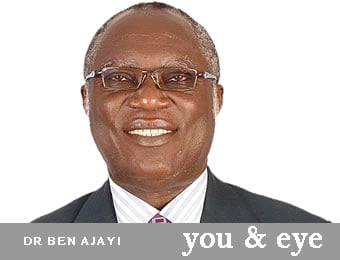Femi Williams, a Professor of Pathology, was one of our favourite teachers in the then Faculty of Medicine, University of Ibadan. Willy Sarcoma (WS), as he was fondly called was big, brilliant, talked big and always in a bow-tie. He would walk majestically into the lecture hall and deliver a smooth one hour lecture without any notes.
“There are 150 causes of Optic Atrophy but I will give you only 120,” he would say. We would listen with rapt attention as he reeled out the causes, one by one, waiting for him to stumble because we felt there was no way he could keep all in his head.
He always disappointed us by his effortless delivery as if he was reading a script. Pick any textbook of Pathology, you would find your lecture notes contained a lot more stuff!
Tambuwal’s Information Commissioner defects to APC
It was amazing how WS came to my mind. That morning, I wore a bow tie! The first patient who walked into my consulting room was this 40-year-old lady who complained of seeing rainbows or haloes around lights since the past three months.
I waited patiently for her to tell her story and asked a few more searching questions. Even before examining her eyes, I had narrowed down the possible causes to five.
“What is her problem?” I asked my young colleague who had been listening. “Glaucoma,” he answered. “On what assumptions did you base your impression?” I asked. He did a good job of it, laying down the principles of how and why a patient would see haloes around lights.
“Doctor, give me five common causes of her symptoms.” I asked again. He was too slow coming out with them so I took over. “There are over 120 possible causes of seeing haloes around lights, but I will give you only 50.”

He looked dazed. I could read incredulity written on his face. He definitely thought I was bluffing. The cock crowed! Suddenly, I remembered my great teacher, WS. “Now, I am beginning to sound like him.” I thought to myself.
Having committed myself, I knew I had to go the whole hog. “Doctor,” I said. “The cause would depend on associated symptoms and signs. If the patient sees haloes and has blurring of vision, there are at least 10 causes; if the haloes are associated with pain, I can immediately think of another 10 causes.
I could recall eight causes each, for haloes associated with other visual problems, behavioural and mental problems. Then there could be a multiplicity of symptoms with various combinations. In no time, I had given more than 50 causes.
“You are a genius sir!” He exclaimed, apparently impressed with the smoothness of the delivery. “Not at all!” I replied. “Then how do you do it?” He asked again. “You provided me with all the answers and more when you laid down the basic principles of how an eye could form haloes. I just built on the foundation you have laid.” I said in reply. It was his turn to ask, “What has this lady then?”
“First of all, let us recall her symptoms – three month history of seeing haloes with some blurring of vision. There is no pain or redness and no headache. The eyes look normal externally; the space between the cornea and the iris is deep; looking inside the eyes, there is evidence of damage to the nerves at the back of the eyes and the intra-ocular pressure is very high – more than two times the normal range.”
“This is definitely chronic glaucoma. I was right!” He exclaimed. “You were right but not quite. We still need to examine the angles of the eye to determine if they are open or closed. Ordinarily chronic glaucoma patients don’t see rainbows except the angles are narrow or the pressures are very high as in this case. This distinction is therefore important and crucial for correct management.”
The patient has been listening to our conversation all along. She has now become worried. “Am I going blind?” She asked. Just as I was about to answer, my vision became blurry. I thought I was seeing haloes.
My tie was too tight! Quickly, I adjusted my bow tie and felt immediate relief. “Your eyes will outlive you” I replied, “if you follow our instructions, use your medicines and pray.”
- This article, first published in February 2009 under the same title. It is repeated in honour of the memory of Professor Akinwole Olufemi Williams who passed on to eternal life and was interred on January 31, 2019. May his soul rest in peace. Amen






